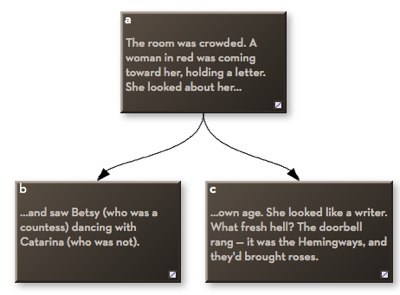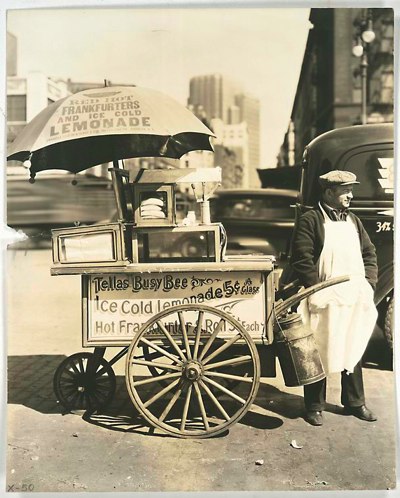Coover Links
Though we’ve been writing for the Web for ages — and some of us were reading and writing hypertext before the Web existed — there’s still a lot we don’t know.

Consider Coover Links — links in which the start of a sentence lies in one side of the link while the end of the sentence lies at the other. Coover links are named for Robert Coover, the author of a short hypertext “Heart Suit” (McSweeney’s 16, 2005) written entirely in this fashion.
Coover himself uses Coover links in a shuffled-deck hypertext — see its name was Penelope and Forward Anywhere for other shuffled decks. In node/link hypertexts, they seem most natural when moving from the end of one page to the start of another. Stretchtext hypertexts can embed Coover links at any point.
Coover links present lots of interesting questions that have not been explored much (or at all), either in art or criticism or theory. Some that spring to mind include:
- How do Coover links interact with rules of grammar? For example, it's probably easier to write multiple destinations if the opening fragment is a prepositional phrase, as above, than if it contains a subject and verb.
- Are Coover links difficult to translate into some languages? I imagine sensitivity to word order would make some Coover links extraordinarily difficult to translate from English to French, or from German to English. (But what fun you could have with German verbs!)
- A writer, revising a hypertext story, decides to begin Q in mid-sentence. Two nodes, O and P, link to Q, and so she revises these nodes to end in mid-sentence (see above). But O and P link to other nodes besides Q, and now these need to be revised as well. But, not every node needs a Coover link just because Q has one. Use graph theory to characterize the set of hypertext nodes the author needs to revise.
- Write a hypertext (or hypertext fragment) in which some nodes end with the first line of a couplet, and the destinations begin with the concluding line (or, perhaps, with the last three lines of an ABBA quatrain). Proceed, with variations.
This is by no means exhaustive. And while I think all these problems are things that an undergraduate could easily tackle — yes, I’m talking to you — these are all at the frontier of knowledge. And they could have real impact: how many thousands of web pages, from Twitter digests to the New York Times, end with clumsy "next" links? Can Coover links replace “there’s more…” in weblogs?
A paper on any of these topics would be well received at Hypertext 2009, coming next June 29-July 1st in Torino, Italy.
The market is collapsing, we’re all staring at a new Depression, and I’m talking about going to Europe now? Am I crazy? But, yes, this is what you should be thinking about now. We may all end up with fruit carts. But it’s a lot better to have a good cart on a good corner; conference publications and contacts are good for you.
